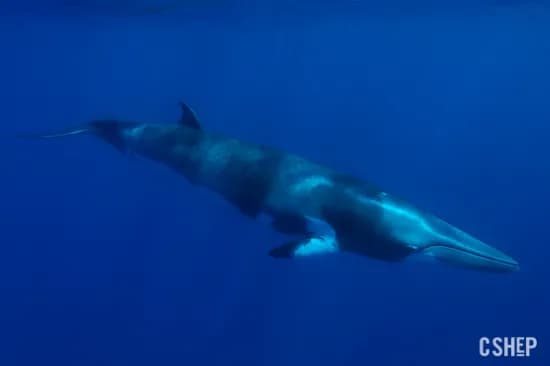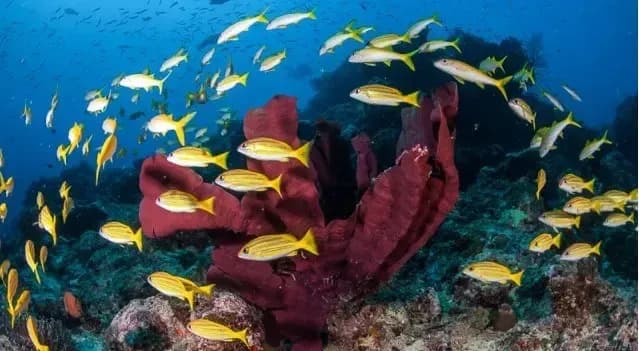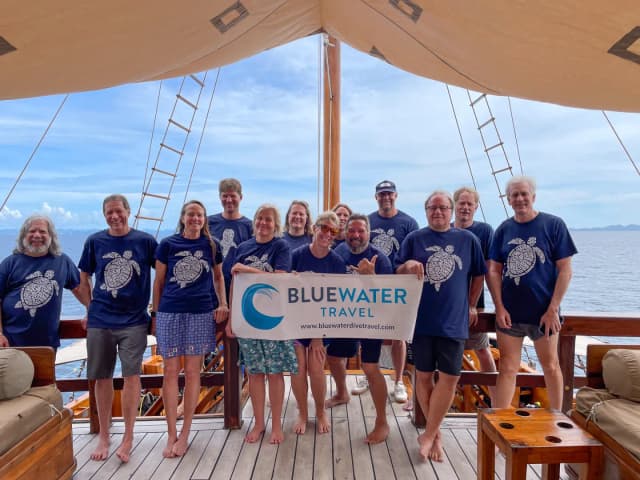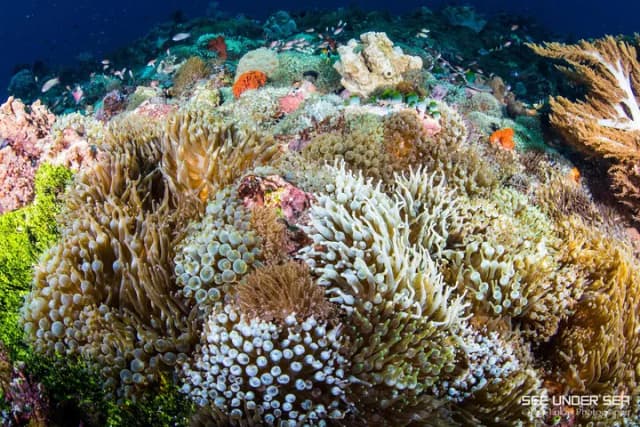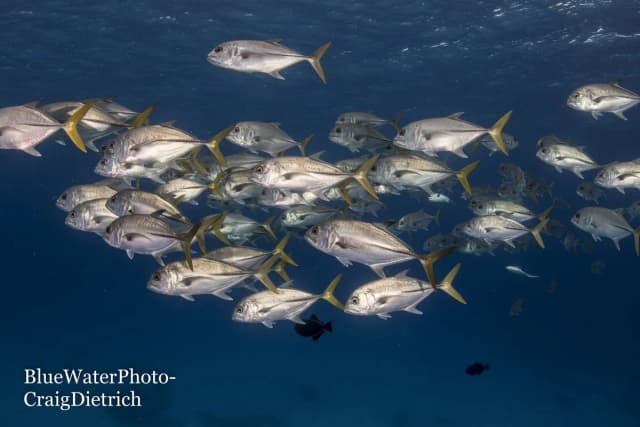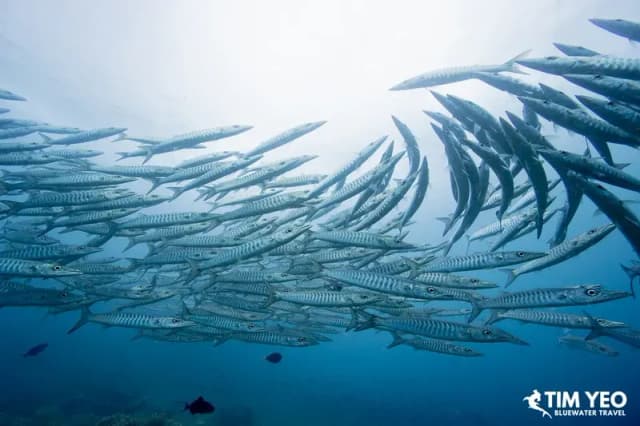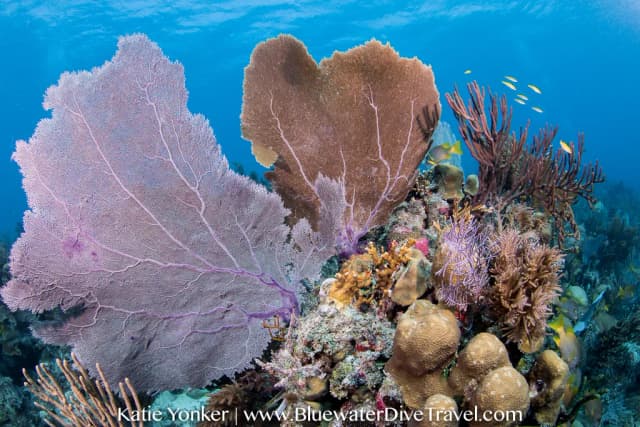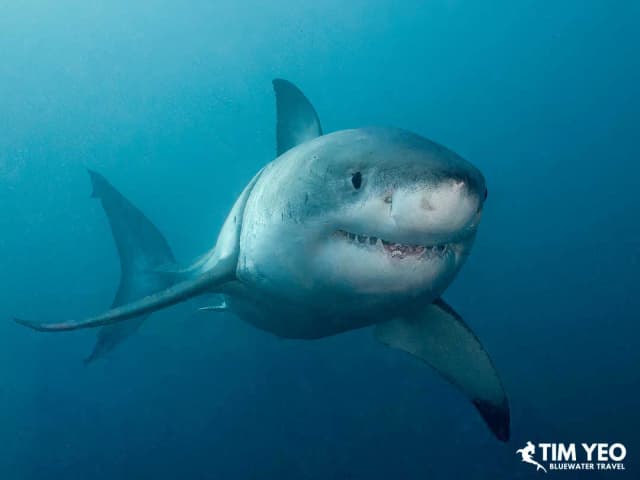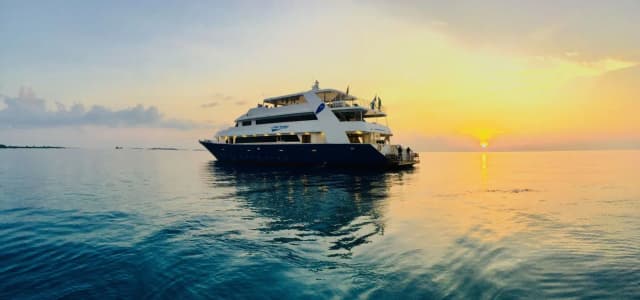The best wreck diving in the world is sought after by curious recreational divers, history buffs, and elite technical wreck divers. Why? Wreck diving is an experience quite unlike any other underwater adventure. For some, the thought of venturing into the dark recesses of a submerged scrapyard is intimidating or even frightening, while others relish the opportunity to explore a shipwrecks hidden past. For the novice wreck diver not trained in penetration, simply swimming around the outside superstructure is exciting in itself and no more difficult than diving a reef.
Shipwrecks are often described as artificial reefs due to the abundance of marine life that they attract. This only adds intrigue, bringing color and life to a seemingly ugly tangle of metal. The photo opportunities are endless, and wrecks bring a whole new dimension to underwater photography. Use your wide-angle lens to capture the impressive structure, or take your macro lens to shoot the tiny inhabitants of the artificial reef. You may want to dive the same wreck several times to explore it and maximize its photography potential thoroughly.
Here at Bluewater Dive Travel, we've selected some of our favorite wrecks and compiled a list of the best wreck dives in the world. Don't forget your wide-angle lens!
Best Wreck Dives In The World
1. SS Yongala, Great Barrier Reef, Australia
The SS Yongala is one of the best dive sites on the Great Barrier Reef. It sits at 98 ft on an open sandy seabed within the Great Barrier Reef Marine Park. The ship sank off Cape Bowling Green, Queensland in March 1911 but was not rediscovered until 1958. The 358-foot wreck is now an incredible artificial reef, with every surface covered in vibrant hard and soft corals and sea fans swaying in the brisk current.
Divers can expect encounters with large marine life, including huge groupers, eagle rays, turtles, and schools of barracuda and trevallies. Manta rays and sharks sometimes patrol the area beyond the wreck. From June to November, dwarf minke whales and humpback whales may also make appearances.
Although penetration is prohibited, this large wreck offers an incredible dive experience, showcasing the best of the Great Barrier Reefs biodiversity in a unique environment.
Learn more about the Great Barrier Reef.
Practical Information
Nearest Airport: Cairns Airport (CNS).
Diving Season: Year-round.
Water Temperature: 73 to 84oF (23 to 29oC).
Depth: 49 - 108 ft.
Difficulty: Depth allows for all levels of diver, but the stronger currents require some experience.
To dive the SS Yongala, view the availability of the MV Spoilsport and book online at the best price!
2. SS Thistlegorm, Red Sea
A favorite among divers worldwide, the SS Thistlegorm is an exciting wreck in the northern Red Sea, famous for its cargo of military supplies. Lying in around 100 ft of water, it offers intriguing swim-throughs and holds still packed with motorbikes, jeeps, and a shipment of Wellington boots! Liveaboards include the Thistlegorm on their northern "reefs and wrecks" itineraries, often allowing divers to explore the wreck over several dives. Follow your guide through the interior passageways for a haunting, surreal experience.

The Thistlegorm was bombed en route to Alexandria, Egypt, in 1941, causing an explosion that split the ship in half and spread much of her cargo across the seabed. Exploring the outside of this 490 ft wreck is just as fascinating as venturing inside, with piles of ammunition, two steam engines, and an anti-aircraft gun still in place.
Heavy currents and persistent damage from dive boats have steadily contributed to the disintegration of the Thistlegorms superstructure. However, both hard and soft corals, as well as interesting macro life, can still be spotted among the rusting framework. This fascinating wreck is suitable for all diving levels and offers visitors a unique glimpse into wartime history.
Learn more about diving the Red Sea.
Practical Information
Nearest Airport: Sharm El Sheikh International Airport (SSH).
Diving Season: March to December.
Water Temperature: 75 to 79oF (24 to 26oC).
Depth: 52 - 105 ft.
Difficulty: All levels, but currents may be challenging.
To dive the SS Thistlegorm, view the availability of the Emperor Superior, Blue Horizon (Red Sea Master), or the M/Y Blue Melody Liveaboard and book online at the best price!
Find out about Aggressor trips to the Red Sea or other great destinations.
3. USAT Liberty, Bali, Indonesia
Lying only 100ft offshore on the Indonesian island of Bali, the USAT Liberty was torpedoed and beached near Tulamben in 1942 before being washed back into the sea by the eruption of nearby Mount Agung in 1963. The 412ft army cargo ship sits on a sandy slope between 10 and 98ft, becoming Bali's most famous dive site and one of the best-known in Southeast Asia.
The Liberty is a stunning artificial reef, blanketed with corals, tube sponges, and gorgonian fans. A diverse array of reef fish inhabits its ledges and overhangs. Expect to see schools of trevally, bream, and anthias, alongside batfish, angelfish, sweetlips, and butterflyfish. On the sandy seabed, watch for garden eels, gobies, and blennies performing their rhythmic dance.
The Liberty's location and shallow depth make it accessible to all skill levels, including snorkelers. Beginners can enjoy short swim-throughs, while deeper exploration is recommended for more experienced divers.
Learn more about scuba diving in Bali.
Practical Information
Nearest Airport: Ngurah Rai International Airport (DPS).
Diving Season: Year-round.
Water Temperature: 81 to 84oF (27 to 29oC).
Depth: 10 - 98ft.
Difficulty: Suitable for all levels, including snorkelers.
To dive the USAT Liberty, book a stay at Liberty Dive Resort, Ocean View Tulamben, Villa Markisa, or Paradise Palm Beach Bungalows.
OR
View the availability of liveaboards Damai I, or Damai II!
4. Fujikawa Maru, Chuuk (Truk) Lagoon
Located at the heart of the largest ship graveyard in the world, Fujikawa Maru is the pice de rsistance of over a hundred military wrecks, casualties of Operation Hailstorm, the Allied bombing of the Japanese fleet during WWII. As a transport ship, much of her fascinating cargo is still in place; however, the main attraction has to be several virtually untouched Zero fighter planes resting in the second hold.
Much of the wreck's outside is encrusted in coral, attracting a wide variety of marine life, including some interesting macro. In particular, the guns at the bow and stern, misshapen by colorful sponges and crinoids, make for a fantastic photo. Keen eyes might also spot one of a variety of shark species patrolling between the wreckage.



With the main superstructure at a depth of only 30ft, the Fujikawa Maru is a great recreational dive, and Chuuk Lagoons clear waters and lack of current means that many of the intact wrecks and artifacts scattered across the sea bed are free from silting. The whole area has a sense of being frozen in time, a ghostly window into the past.
For those eager to explore Truk Lagoon's 'Ghost Fleet,' the Odyssey Adventures Truk Lagoon liveaboard offers unparalleled access to these historic WWII wrecks with top-tier diving facilities.
Learn more about Truk Lagoon.
Practical Information
Nearest Airport: Chuuk International Airport (TKK).
Diving Season: Year-round. May to December is the rainy season, which can reduce visibility. Truk Lagoon is on our list of recommended destinations to dive in December!
Water Temperature: 81 to 86oF (27 to 30oC).
Depth: 30 - 110ft.
Difficulty: All levels.
To dive the Fujikawa Maru, book a stay at the Truk Blue Lagoon Dive Resort
OR
view the availability of the liveaboards SS Thorfinn or Odyssey Adventures!
5. SS President Coolidge, Vanuatu
Another casualty of WWII, the SS President Coolidge was a huge luxury liner, pressed into service as a troop carrier during the war. In early 1942, she hit two mines trying to enter the harbor on Espiritu Santo island, beached on the nearby reef, and then slid down to her current position at a depth of 70 to 240ft. The 5,340 evacuated troops left all their personal and military belongings on board, making for a fascinating underwater museum of artifacts protected from removal by the Vanuatu government. The most photographed icon on board is a porcelain panel known as The Lady, still in good condition and with the original colors visible.

Accessible from the shore and with much to offer both recreational and technical divers, there are around 50 dives on this massive wreck, and many visitors to Vanuatu will dive exclusively on the President Coolidge. Marine life is abundant, and many of the South Pacifics key species make an appearance. Expect to spot turtles, moray eels, and barracuda sheltering amongst the wreckage, with the occasional reef shark patrolling in the background.
The SS President Coolidge is an exceptional wreck that keeps on giving. Every dive will leave you wanting to explore more.
Learn more about diving Vanuatu.
Practical Information
Nearest Airport: Bauerfield International Airport (VLI).
Diving Season: Year-round.
Water Temperature: 72 to 82oF (22 to 28oC).
Depth: 70 - 240ft.
Difficulty: All levels.
6. USS Kittiwake, Grand Cayman, Cayman Islands
One of the Caribbeans best-known dives, the USS Kittiwake, is a former WWII military ship that was purchased and scuttled by the Cayman Islands in an attempt to diversify the regions dive portfolio. Sunk in 2011, the 250-foot wreck is situated just off Grand Caymans Seven Mile Beach, and in only 75 feet of water, it offers divers an excellent introduction to wreck diving. She was originally upright until huge swells from Tropical Storm Nate ripped the bridge open and tipped her onto her port side in 2017.
As a relatively young wreck, the Kittiwake has yet to develop the variety of marine life found at other similar sites; however, a good amount of macro can still be spotted amongst her superstructure. Schools of horse-eyed jacks, barracuda, and turtles patrol her outer reaches, while southern stingrays and eagle rays are often seen in the surrounding sand. Minimal colonization by corals and sponges means much of the metalwork remains visible, and the compass and steering wheel, ships bell, and two recompression chambers are all easy to identify.
Close to shore and in relatively shallow water, the USS Kittiwake is an excellent first-time wreck dive. It also offers more experienced divers a unique taste of a pristine wreck. With the top in only 27 feet of water, snorkelers can enjoy much of it.
Learn more about the Cayman Islands.
Practical Information
Nearest Airport: Owen Roberts International Airport (GCM).
Diving Season: Year-round.
Water Temperature: 72 to 82oF (22 to 28oC).
Depth: 27 - 75ft.
Difficulty: All levels, including snorkelers.
To dive the Fujikawa Maru, book a stay at the Compass Point Dive Resortor view the live availability of the Cayman Aggressor V.
7. USS Oriskany, Florida, USA
The USS Oriskany is the largest artificial reef in the world, and one of only three aircraft carrier wrecks accessible to recreational divers, creating a one-of-a-kind experience. Located 22 miles off Pensacola in Floridas panhandle, the 60-year-old ship was sunk in 2006 as part of a US Navy program to recycle decommissioned ships for economic and marine benefits.
Like the Kittiwake in Grand Cayman, the Oriskany is a fairly young wreck, and it has taken time for marine life to colonize their new reef. Increasing numbers of tropical fish are starting to move in, while grouper, amberjack, and tuna are regularly spotted nearby. A good part of the superstructure is shallower than 100ft, and divers with a variety of skill sets can thrill in exploring her bridge, flag bridge, and pilothouse, complete with radar and navigation equipment still in situ.
At over 900ft long and with a beam of 148ft, visitors return again and again to explore this vast and fascinating wreck, making it one of the most popular in the US.
Learn more about Florida.
Practical Information
Nearest Airport: Pensacola International Airport (PNS).
Diving Season: Year-round.
Water Temperature: 65 to 82oF (18 to 28oC).
Depth: 80 - 210ft.
Difficulty: All levels, with some currents, swell, and poor visibility in the winter.
8. Hirokawa Maru, Solomon Islands
Known locally as Bonegi 1, or simply "B1", the Hirokawa Maru is the best preserved of three Japanese cargo ships that ran aground in the Solomon Islands during the American bombardment of Japanese forces in 1942. Accessible as a shore dive from Bonegi Beach, west of Honiara, the top of the wreck lies in just 16 feet of water, with the stern dropping down to 196 feet. Colorful hard corals and large sea fans cover gaping holes in the superstructure, all in the same excellent condition as the natural reefs throughout the Solomon Islands.
While her stern is in one piece, the Hirokawa Marus bow is fairly broken up and can be quite confusing to dive. Sponges, gorgonians, and hard and soft coral add to the misshapen jungle of debris that, with increased depth, gradually identifies as the ships hull. Expect to swim through schools of snapper, butterflyfish, sweetlips, and batfish, as well as the usual bright hue of bassets and fusiliers.
This 510-foot wreck needs to be dived several times to fully explore all it has to offer. Shallow and with beach access, it also provides a great adventure for snorkelers.
Learn more about the Solomon Islands.
Practical Information
Nearest Airport: Honiara International Airport (HIR).
Diving Season: Year-round.
Water Temperature: 80 to 85oF (26 to 29oC).
Depth: 16 - 196ft.
Difficulty: All levels, including snorkelers.
To dive the Hirokawa Maru, view the live availability of the Solomons Master.
9. U-352, North Carolina, USA
Considered one of the best wrecks in North Carolina, the hull of this German U-boat lies in 110 feet of water off Cape Hatteras in the Outer Banks. She was sunk by USCG Cutter Icarus in 1942 and rediscovered in 1975 in what is now known as the Graveyard of the Atlantic. Her hull is mostly intact, restricting any penetration, but there is visible damage from the torpedo strike that sunk her. Debris scatter on the sandy seabed is spread across a 330-foot radius.
This wreck is a fascinating artificial reef, heavily encrusted in soft coral and anemones. Large schools of red barbier baitfish and amberjacks abound and expect to come across lionfish lurking under the keel. Visibility of up to 100ft and the warmer waters of the Gulf Stream make this a great North American wreck to explore.
Read Tanya Houppermans account of diving with sand tiger sharks on North Carolinas wrecks.
Practical Information
Nearest Airport: Wilmington International Airport (ILM).
Diving Season: May to November.
Water Temperature: 68 to 80oF (20 to 26oC) during the season.
Depth: 110ft.
Difficulty: All levels, although conditions can be more challenging at either end of the season.
10. Iro Maru, Palau
The Japanese oil tanker Iro Maru is one of over 60 military ships that were sunk in Palau during WWII. Today, many of the wrecks have been salvaged or removed; however, the vast Iro Maru is considered one of the best remaining to explore. She sits upright at a maximum depth of 130ft, with much of the deck, bridge, and mast above 80ft.

Whilst she has some great penetration dives for those with experience, there's also plenty to see on the outside superstructure. The forward and aft guns are still in situ and there is a good amount of ammunition spread across the wreck and the surrounding seabed. The bridge is easily accessed, although none of the instrumentation or equipment remains. Palaus vibrant reef life has overrun every inch of this 470ft vessel, her enormous hull festooned in a fantastic array of macro life, nudibranchs, and clams. Anemones and their clownfish add further entertainment, as well as countless other small reef fish.
Learn more about Palau.
Practical Information
Nearest Airport: Roman Tmetuchl International Airport (ROR).
Diving Season: Year-round.
Water Temperature: 81 to 84oF (27 to 29oC).
Depth: 65 - 130ft.
Difficulty: All levels.
To dive the Iro Maru, view the availability of the Ocean Hunter III, Palau Siren, and Palau Aggressor II, and book online at the best price!
Other Places In The World With Amazing Wreck Dives
Of course, there are many other places around the globe where scuba divers can explore fantastic wrecks as well as the marine environments surrounding them.
Arguably the pinnacle of wreck diving destinations, Bikini Atoll is difficult to reach and suitable only for technical divers. As such, very few have explored the atoll's controversial sunken fleet.
Coron is the wreck-diving capital of the Philippines, with some experts even saying it's the best in Southeast Asia. During World War II, the Americans bombed and sunk a fleet of Japanese ships, many of which remain well-preserved (with ammunition and fixtures still intact) and teeming with marine life. Aside from the wrecks, divers will enjoy the healthy reefs and vast underwater caverns.

Coron Bay Wreck
Coron may be the Philippines' best-kept secret, but probably not for long, as more and more people are heading there for not only the amazing diving but also the breathtaking limestone cliffs, white-sand beaches, and brilliant blue-green waters!
Well-known for its pristine coral reefs, extremely rich marine life, and exotic culture in off-the-beaten-path locations, Papua New Guinea, or PNG, is also home to a variety of World War II wrecks such as ships, aircraft, and submarines. This is the perfect destination for scuba divers who enjoy taking photos of the metal structures.


Photos from BWT's recent trip to Papua New Guinea, led by Mark Strickland
The east coast of Sri Lanka is also renowned for its shipwrecks, including the WWII aircraft carrier HMS Hermes, which offers some excellent recreational and technical dives.
Or check out the diving Borneo, particularly the small country of Brunei, where several military wrecks are sunk just off shore.
Scuba dive the history-rich islands of Malta and Gozo, which are surrounded by wrecked ships and planes.
Liveaboards are an excellent way to explore shipwrecks. Find out more about our best liveaboard destinations.
Where have you seen the best wreck diving in your travels? Let us know in the comment section if theres a particularly beautiful area that youd like to recommend!
Got Questions? Ready To Book?
Call us today at +1-310-915-6677 or email us at info@bluewaterdivetravel.com








